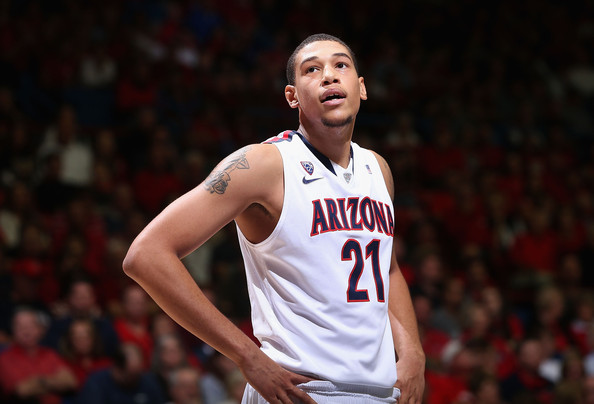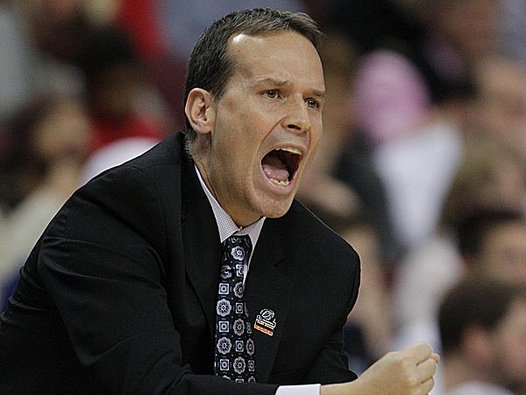Otskey’s Observations: Episode XI
Posted by Brian Otskey on February 5th, 2014Each week throughout the season, RTC columnist Brian Otskey (@botskey) will run down his observations from the previous week of college basketball.
Early Returns on Chris Collins Look Great
When former Duke associate head coach Chris Collins was hired at Northwestern this past spring, many felt it was only a matter of time before the local guy from Northbrook, Illinois, would build up the program to a level where it could achieve its first-ever NCAA Tournament bid. After a 7-9 (0-3 Big Ten) start to the season, Collins and Northwestern have righted the ship with wins in five of their past seven games. Most impressive have been the three consecutive wins away from Evanston: at Indiana, Wisconsin and Minnesota. How have the Wildcats done it? Collins has done what any good coach would do — analyze the strengths and weaknesses of his team and implement a style of play that showcases the strengths while minimizing the weaknesses. Northwestern obviously does not have the same talent level as most other teams in the Big Ten so the way to win games is to slow it down, muck it up and play great defense in low possession games. And that is exactly what the Wildcats have done.
Collins has gotten this team to buy in defensively as Northwestern is currently ranked No. 10 nationally in adjusted defensive efficiency. In Big Ten play, the Wildcats lead the conference with a 44.6 percent defensive effective field goal percentage. Since allowing 93 points in a loss at Iowa on January 9, Northwestern has allowed only one opponent (also Iowa) to score more than 56 points in regulation time (Purdue scored 60 in a double-overtime loss to the Wildcats but posted just 46 points in regulation). Northwestern’s games in Big Ten play have averaged only 61.2 possessions with an average possession length of 20.4 seconds, both statistics ranking as the slowest in the Big Ten. Last year’s Northwestern team was dead last in defensive efficiency (in league play) under Bill Carmody which shows you how absolutely remarkable it is that Collins has gotten this group to defend at a high level in such a short period of time. While you never want to get ahead of yourself, at this point it would be a surprise if Northwestern doesn’t make the NCAA Tournament over the next five years when you also consider how well Collins is already doing on the recruiting trail.
Syracuse and Duke Exceeds the Hype
Syracuse’s thrilling overtime victory over Duke last Saturday was one of the best regular season college basketball games I can remember in quite some time. It had everything you would want in a big game: a terrific atmosphere with over 35,000 fans in attendance; two Hall of Fame coaches; league title implications (Syracuse entered the game at 7-0, Duke at 6-2); tons of talent on the floor; and an extremely high level of play. Consider this: Syracuse won an overtime game by two points on its home floor and posted an outrageously high offensive efficiency of 1.34 points per possession. It took that good of an offensive performance to stave off the Blue Devils, which posted 1.31 PPP themselves. It is going to be very difficult to top that game but I am very excited for the rematch at Cameron Indoor Stadium on February 22. Duke and North Carolina will always be the best rivalry in the ACC and arguably in all of college basketball, but Duke and Syracuse appear to be on their way to another terrific rivalry in what has become a bloated ACC. This new rivalry has the potential to exceed what Duke and Maryland had going for some time as a secondary ACC rivalry now that Maryland will be moving on to the Big Ten next season.
Impact of Brandon Ashley’s Injury on Arizona
In its Saturday night first-loss-of-the-season to California, Arizona suffered a much more serious setback than that. Sophomore forward Brandon Ashley broke his right foot early in the game against the Golden Bears and will miss the rest of the season because of it. The loss of the team’s third leading scorer (11.5 PPG), who shot 52.2 percent from the floor in nearly 28 minutes per game, is a huge blow to Sean Miller’s Wildcats. Ashley, at 6’8”, was a guy who could stretch defenses out to the mid-range area and open up things inside for Arizona’s power game. While he is not nearly the three-point threat that Erik Murphy was for Florida last season, his role for Arizona was similar in a way. That is going to be missed but the good news is that Arizona has guys capable of stepping up, namely Aaron Gordon and Rondae Hollis-Jefferson.

The loss of Brandon Ashley could really hurt Arizona’s title chances. (Christian Petersen, Getty Images North America)
If Arizona goes small in Ashley’s absence, more minutes will be available for Gabe York, a guy who can fill it up from deep in a hurry. Arizona doesn’t shoot many three-pointers to begin with, but it has capable shooters out there in York and Nick Johnson. With Ashley out (who ironically didn’t take many threes), Arizona may become more perimeter-oriented offensively in order to open up the middle for easy buckets in the paint. The Wildcats are not an elite offensive team, ranking sixth in Pac-12 play in offensive efficiency and No. 35 nationally on the season. The Wildcats are likely to remain strong defensively (currently No. 1 in adjusted defensive efficiency), but it is on offense where Ashley’s loss will hit the hardest. Arizona now has one fewer weapon to deploy on that end of the floor and his teammates are going to have to step up in his absence. Since 2003 when Ken Pomeroy began tracking advanced metrics, no national champion has ever finished the season with worse than a No. 18 offensive efficiency ranking. Unless Arizona can somehow improve its offense without Ashley, history is not on its side.
Surprising Leader in the American
Before the season, most people thought Louisville would run away with the American Athletic Conference title in its first and only year in the newly-formed league. The Cardinals were a unanimous choice to win the conference (Rick Pitino could not vote for his own team), finishing 12 points ahead of second place Connecticut in the voting. This is a good example of why preseason coaches’ polls should always be taken with a grain of salt. As of this writing, Louisville stands two games behind surprising leader Cincinnati in the loss column. The Bearcats are 10-0 with eight games to play and have already beaten the Cards in Louisville. If you were looking for Mick Cronin’s team in the preseason American poll, you’d have to go all the way down to fourth place in a 10-team league to find the Bearcats with 58 points.
Cincinnati’s fortunes changed with a win against Pittsburgh at Madison Square Garden on December 17, a game I happened to attend. While it was definitely ugly, it was a hard-fought win for the Bearcats and you could see the relief on their faces after the game. Cincinnati was coming off two straight losses (to New Mexico and rival Xavier) and needed that win in the worst way. It was the beginning of the Bearcats’ current 14-game winning streak. While Cincinnati’s schedule certainly has not been brutal, it has beaten a decent SMU team as well as Memphis and Louisville, both on the road, in that span. The Bearcats appear to be for real and they are doing it with defense yet again. Stopping teams has been the key to Cronin’s success at UC, particularly over the last few seasons. Cincinnati has finished No. 14, 22 and 14 in adjusted defensive efficiency over the last three years and currently ranks No. 5 so far this time around. You could say that the Bearcats are offensively challenged but they have a stud in Sean Kilpatrick (19.4 PPG) and hit the offensive glass hard, resulting in lots of extra possessions and points. Cincinnati ranks fifth in the AAC in offensive efficiency but that’s not a bad place to be when its defense is playing at an elite level. The bottom line is that on February 5, Cincinnati is in the driver’s seat to win the American and Louisville still has to visit Fifth Third Arena. Back on November 5, I am not sure many, if any, pundits would have predicted that.












































